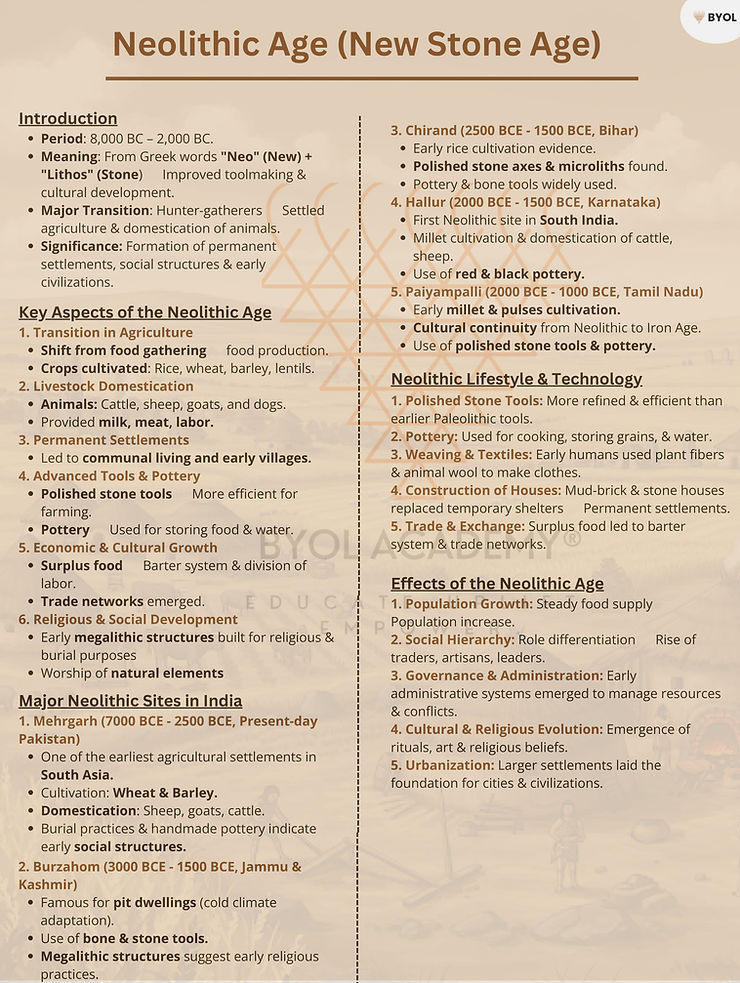Introduction
The Neolithic Age, also referred to as the New Stone Age, represented a pivotal period in human history. A hunter-gatherer lifestyle gave way to settled agriculture and animal domestication during this time, which roughly corresponded to 8000–2,000 BC. Originating from the Greek words “neo” (new) and “lithos” (stone), the term “Neolithic” refers to the improvements in toolmaking and cultural development that occurred during this time period. The establishment of permanent settlements, social institutions, and technological advancements that eventually paved the way for the emergence of civilizations were all made possible during the Neolithic Age.
Key Aspects
- Transition in Agriculture: The transition from gathering food to producing it was the most distinctive feature of the Neolithic era. In order to guarantee a steady source of food, early people started growing crops like rice, wheat, barley, and lentils.
- Livestock Domestication: By domesticating livestock like cattle, sheep, goats, and dogs, a reliable supply of milk, meat, and labor was made available.
- Substantial Communities: As agriculture developed, people built permanent communities, which paved the way for the emergence of communal living.
- Better Tools and Earthenware: During the Neolithic era, polished stone tools, food and water storage earthenware, and clothing weaving were developed.
- Cultural and Economical Improvements: A more organized civilization resulted from the expansion of surplus food, which sparked trade, barter systems, and the division of labor.
- Religion and Social Progress: Possibly for religious reasons, early people started constructing megalithic buildings and worshiping the natural world.
Neolithic Sites in India
The Neolithic Era in India is characterized by regional variances, with sites located across the subcontinent. Among the important Neolithic sites are:
| 1. Mehrgarh (7000 BCE – 2500 BCE, Present-day Pakistan) | One of the earliest agricultural settlements in South Asia.Evidence of wheat and barley cultivation.Domestication of sheep, goats, and cattle.Handmade pottery and burial practices indicate early social organization. |
| 2. Burzahom (3000 BCE – 1500 BCE, Jammu & Kashmir) | Famous for its pit dwellings, indicating adaptation to cold climates.Use of bone and stone tools.Evidence of hunting, domestication, and rudimentary farming.Megalithic structures found in the region suggest early religious beliefs. |
| 3. Chirand (2500 BCE – 1500 BCE, Bihar) | Known for early agriculture, including rice cultivation.Use of polished stone axes and microliths.Pottery and bone tools were widely used.Evidence of cattle rearing and fishing. |
| 4. Hallur (2000 BCE – 1500 BCE, Karnataka | First Neolithic site in South India.Evidence of millet cultivation and domestication of animals like cattle and sheep.Use of red and black pottery.Simple mud houses indicate permanent settlements. |
| 5. Paiyampalli (2000 BCE – 1000 BCE, Tamil Nadu) | Known for early farming activities, particularly millet and pulses cultivation.Evidence of cultural continuity from Neolithic to the Iron Age.Use of polished stone tools and pottery. |
Neolithic Lifestyle and Technology
The Neolithic Era’s innovations in technology were extremely important in forming human civilization. Among the essential components are:
| Polished Stone Tools: | More refined and efficient than earlier Paleolithic tools. |
| Pottery: | Used for cooking, storing grains, and water. |
| Weaving and Textiles: | Early humans started using plant fibers and animal wool to make clothes. |
| Construction of Houses: | Mud-brick and stone houses replaced temporary shelters, leading to permanent settlements. |
| Trade and Exchange: | The surplus food production led to barter systems and trade networks among communities. |
Effects of the Neolithic Era
The following are some of the significant effects of the Neolithic Revolution on human society:
- Population expansion: A steady supply of food led to a rise in population.
- Societal inequality: Role differentiation that gives rise to traders, artisans, and leaders.
- Administration Growth: In order to handle resources and disputes, early governance frameworks were established.
- Historical Change: The emergence of religious beliefs, art, and rituals.
- Urban development: The establishment of sizable communities that ultimately paved the way for the development of cities and civilizations.
The Neolithic Age was a pivotal time that established the foundation for contemporary societies. The history of mankind was shaped by the economic, social, and technological shifts brought about by the shift from nomadic to sedentary agriculture. Neolithic monuments in India, including as Mehrgarh, Burzahom, and Chirand, offer important insights into the lifestyles and settlements of early humans. The development of a structured and organized civilization began during this time, and the innovations developed during this time were essential for the Bronze and Iron Ages that followed.





